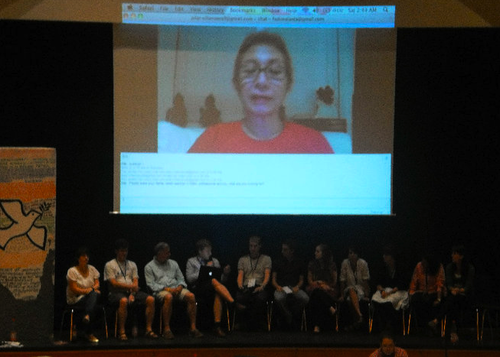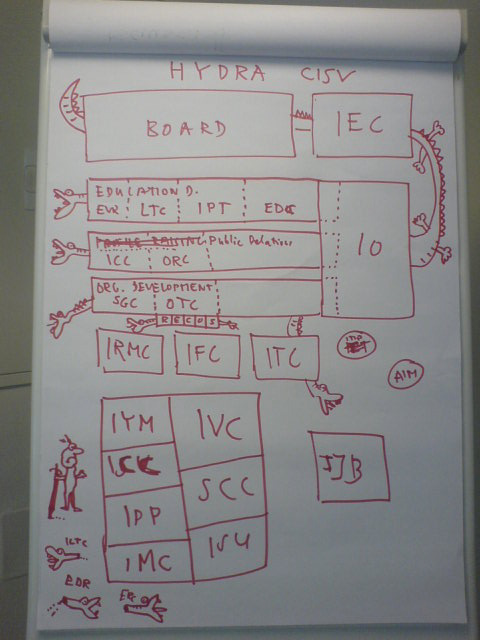Three stories.
1. A medium-sized CISV chapter is desperately trying to fill staff positions for a village. They have a few promising candidates, but 4 weeks before the village is supposed to start, suddenly there's nobody. Not one single staff. Brainstorming ideas, and trying to do anything so that the camp won't get canceled they send e-mails about and are suddenly flooded with applications from experienced CISVers around the world, volunteering to be an international staff in that very village. The chapter is even in the comfortable situation to select some of the applicants and the village finally takes place as planned.
2. A CISVer with a ton of experience both being participant and leader applies for the position as international staff in a Seminar Camp. After being asked to take over the more responsible role as the camp director because of the chronic lack of experienced staff, he agrees to this "upgrade" and gets involved in preparations and bringing the rest of the staff together. Suddenly he is informed by an e-mail from the international committee, that two unfavourable reports, some dating back several years, have lead to the decision that he shall not direct this camp but rather be international staff instead.
Understandably upset he decided not to staff the Seminar Camp at all.
3. In order to expand the competence of their team, the staff of a summer camp invites an experienced CISVer from Israel to join in. The delegations are informed about the new staff member through the third precamp. Also Lebanon is invited to this camp and ever since a Lebanese CISV family got into huge trouble a few years ago, CISV international refrains from putting Lebanese and Israeli kids together in one camp - a rule that the particular hosting chapter was unaware of. After the CISV Lebanon is about to cancel their participation, the (reasonable) decision is made to ask the tentative Israeli staff, who is (understandably) upset, to stay at home.
I don't want to dive into the details of these stories, let alone try and figure out who's fault it was, and what exactly should be changed, but they illustrate that the way we are dealing with international staff is far from ideal in two aspects: Apparently there is a huge potential not being used (compare the costs of flying in an international staff with cancelling a camp). And if this potential is actually being used, a lot of collateral damage is generated by our current way of handling things.
Finding volunteers will be an ongoing challenge for CISV in the future, and at least for international staff we should try and create some form of an official, open, transparent, fair and efficient marketplace system to allocate motivated people to the chapters in need.
1. A medium-sized CISV chapter is desperately trying to fill staff positions for a village. They have a few promising candidates, but 4 weeks before the village is supposed to start, suddenly there's nobody. Not one single staff. Brainstorming ideas, and trying to do anything so that the camp won't get canceled they send e-mails about and are suddenly flooded with applications from experienced CISVers around the world, volunteering to be an international staff in that very village. The chapter is even in the comfortable situation to select some of the applicants and the village finally takes place as planned.
2. A CISVer with a ton of experience both being participant and leader applies for the position as international staff in a Seminar Camp. After being asked to take over the more responsible role as the camp director because of the chronic lack of experienced staff, he agrees to this "upgrade" and gets involved in preparations and bringing the rest of the staff together. Suddenly he is informed by an e-mail from the international committee, that two unfavourable reports, some dating back several years, have lead to the decision that he shall not direct this camp but rather be international staff instead.
Understandably upset he decided not to staff the Seminar Camp at all.
3. In order to expand the competence of their team, the staff of a summer camp invites an experienced CISVer from Israel to join in. The delegations are informed about the new staff member through the third precamp. Also Lebanon is invited to this camp and ever since a Lebanese CISV family got into huge trouble a few years ago, CISV international refrains from putting Lebanese and Israeli kids together in one camp - a rule that the particular hosting chapter was unaware of. After the CISV Lebanon is about to cancel their participation, the (reasonable) decision is made to ask the tentative Israeli staff, who is (understandably) upset, to stay at home.
I don't want to dive into the details of these stories, let alone try and figure out who's fault it was, and what exactly should be changed, but they illustrate that the way we are dealing with international staff is far from ideal in two aspects: Apparently there is a huge potential not being used (compare the costs of flying in an international staff with cancelling a camp). And if this potential is actually being used, a lot of collateral damage is generated by our current way of handling things.
Finding volunteers will be an ongoing challenge for CISV in the future, and at least for international staff we should try and create some form of an official, open, transparent, fair and efficient marketplace system to allocate motivated people to the chapters in need.



